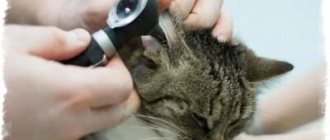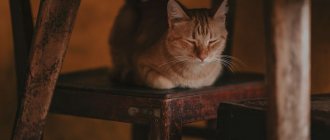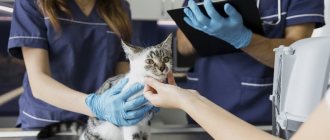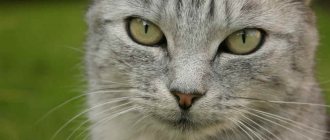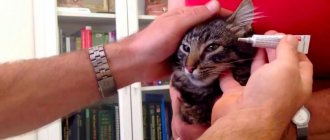5327Pavel
1
Experts have identified a large number of bone and paw diseases in cats, some of which appear in animals much more often than others. Some paw diseases in cats make themselves known early and can go away instantly if treatment is started on time. In case of hopeless forms, it is recommended to seek help from a specialist as soon as possible so that the veterinarian can prescribe competent treatment.
The most popular problems in cats and cats are:
- breaking, cracking and ingrown claws
- damage, cracks and foreign objects in the paw pads
© shutterstock
Problems must be eliminated, so the cat will feel out of danger, feel comfort and care from the owners, and will trust the person more.
Ingrown claws in cats
Cats need to scratch non-stop to keep their claws sharp and clean. When members of the cat family are unable to sharpen their claws, health problems occur. For pets, you need to install a scratching post at home so that cats can have the opportunity to stretch their claws without any problems.
Ingrowth occurs more often in cats that are not very active. Therefore, the owner needs to monitor the condition of the animal’s claws and maintain them in a normal form - trim off the excess so that the paw pads do not grow into the soft tissues. Because of this, the paw will hurt, and inflammation and even a purulent process may begin in the claw area due to the accumulation of dirt in this place. In this case, the veterinarian should prescribe medication for the cat.
If the problem is not treated, the inflammatory process will cause discomfort and pain to the animal, prevent the cat from moving normally, and the animal will limp. It is recommended to trim ingrown claws at home with special pliers, or use the services of a specialist.
Additional recommendations
The best thing you can do for your cat's paws is to keep her indoors, where she is less likely to get injured, run into too hot or cold surfaces, or step on dangerous chemicals. Cuteness also notes that dry indoor winter air can dry out your cat's paws, so you should use a humidifier in your home during the colder months. Having a scratching post in your home will help keep your cat's claws in good condition—not to mention the carpet and furniture.
Since caring for a furry beauty requires so many different efforts, proper care of her paws is easy to overlook. It's best to make it a habit to check and clean your cat's paws daily to keep them in good shape.
Diagnostic methods
If your cat's pads are cracking, and the wound is bleeding and does not heal for a long time, you should not delay a visit to the veterinarian. After the initial examination, a sample is taken from the affected area for microscopic, cytological and histological examination. The sensitivity of the identified pathogen to antibiotics is also determined.
It is important that the doctor distinguishes the animal’s disease from pemphigus foliaceus in time.
There are other dangerous diseases in which the paw pads peel off and become an unnatural color. Therefore, differential diagnosis must be carried out, which will help exclude such pathologies:
- eosinophilic granuloma;
- neoplasia;
- pemphigus foliaceus;
- injury.
How common is the disease?
Research data on the prevalence of urolithiasis in cats is mixed. Researchers estimate that 0.1-0.4% of visits to the doctor are related to urolithiasis. In fact, statistics only take into account those animals in which sand or stones were found in the clinic. But the disease can occur without visible symptoms, which makes it more difficult to detect. Only in 15% of cases do studies show that the cause of the disease is urolithiasis. When a plug forms in the urethra, the animal experiences similar symptoms. This pathology occurs in 16% of cases, mainly in cats. If there is mucus in the urine, its mixture with crystals can clog the urethra. In this case, urination is completely absent, although the bladder continues to fill. This condition can be fatal and requires urgent medical attention.
Cystitis is the most common disease of the urinary system, accounting for about 55% of all cases. The exact cause of cystitis has not yet been studied, but veterinarians suggest that stress is considered a driving force in the development of the disease. If no concomitant infections are found, antispasmodics and sedatives are prescribed, but also a diet to increase high humidity, reduce urinary excretion and reduce density. In some cases, the cat begins to have difficulty urinating; this may not necessarily be urolithiasis, but in any case, it is worth contacting a specialist.
Breaking off claws and cracks in pads
One of the common paw problems among representatives of the cat family is broken claws and the formation of cracks on the paw pads; this occurs as a result of injury or mechanical damage to the animal’s paw. When a crack appears on the claws, or they break off for any reason, this may be the beginning of purulent inflammation of the corolla, and then the claw will fall off on its own.
© shutterstock
In particularly advanced cases, the corolla and claws are removed surgically. It is necessary to monitor the condition of the cats’ claws, and if sharp ends are detected, remove them painlessly and apply an antiseptic for the wounds. For cracks and damage, a bath with a disinfecting effect is recommended; it helps relieve inflammation and eliminate the problem. In particularly severe cases, veterinary supervision is necessary.
If your cat has cracked paw pads
The causes of cracked paw pads in cats can be very diverse.
Here are the most common:
- lack of vitamins (avitaminosis) and other substances necessary for the body (in particular biotin, vitamins A, B1, B2, B3, B6);
- metabolic disorders (blood biochemistry will help determine the cause);
- fungal skin diseases;
- liver problems ;
- stress;
- excessive dry air ;
- parquet in the apartment;
- poorly flushed cleaning products ;
- incorrectly selected pet shampoo (if you wash your cat frequently);
- cat litter (often cement or clay litters are very drying to cats' paw pads. In addition, cement dust from these litters can cause upper respiratory tract diseases).
And so, having established the cause, you can solve the problem. Show your cat to a veterinarian, take a blood test for biochemistry, make sure there is no fungus or other health problems. Balance your cat's diet and add essential vitamins. Please note that vitamin A is a fat-soluble vitamin, so when giving it, add half a teaspoon of olive oil to your cat's diet. Vitamin B and biotin are found in raw egg yolk. But it is not digested if it is eaten together with raw protein, so give your cat only raw yolk 2 times a week (this is also good for the coat and skin). If the reason is stress, try to level it out, knowing the characteristics of the cat and what could cause stress. Finally, use Feliway. If the problem is excessive dry air, purchase a steam humidifier or place a container of water near the central heating radiators. This will be useful not only for the cat, but also for you and your indoor plants. If the problem is cat litter, replace the clay or cement clumping litter with silica gel. And the best thing is sawdust. Wood filler is environmentally friendly, perfectly absorbs moisture and odors, smells pleasant of wood, does not dry out paws, does not cause allergies, and most importantly, it can be flushed down the toilet.
What to do with cracks that have already appeared on the paw pads?
If the paw pads are dry and begin to crack, it is necessary to regularly lubricate:
- baby cream (preferably odorless) or Vaseline, or any other ointment based on Vaseline or lanolin;
- the best way is to lubricate with sea buckthorn oil (the cat will have to be held in your arms for some time so that the cream or oil is absorbed, about 20-30 minutes, the course of treatment is 7-10 days 3-4 times a day until it disappears completely);
- can also be greased with butter;
- if the cracks are caused by vitamin deficiency RADEVIT vitamin ointment or an oil solution of retinol (vitamin A);
- You can also use gel for paws of dogs and cats, hygienic balm Vedinol or wound-healing veterinary drug Ranosan.
In any case, temporary measures to alleviate the animal's condition are described here. You should not self-medicate. Don’t be lazy, consult with your veterinarian to rule out serious medical causes such as metabolic disorders, liver problems, fungus, etc.
The article was prepared by the Helen Empire ; use on other resources without our consent is prohibited in accordance with the Civil Code of the Russian Federation.
Terms of use of materials from the Helen Empire website - obligatory link to us!!!
Pads to survive
Our beloved cats tiptoe through life. And the point is not in the beauty and grace of such a gait - people with mustaches hardly think about this. Simply walking and running on your toes increases the chances of a successful hunt - thus the swing becomes longer and the speed is higher.
In addition, the pads work as sound absorbers - it’s not without reason that they say: she walked in quietly, like a cat. The pads soften both the sound of a jump and the sound of a step, which is especially important when hunting. A cat that sneaks around on tiptoe is very difficult for potential prey to notice!
The small paw pads contain a large number of nerve endings that help assess temperature and surface texture, as well as sense unevenness, which helps maintain balance.
Also, these nerve endings very sensitively pick up the slightest vibration - this is what is associated with the ability of cats, and many other animals, to “predict” earthquakes. There is nothing mystical here; cats begin to show anxiety several hours before the first tremors, as they sense the slight vibration of the soil that precedes it.
Foreign bodies in a cat's pads
When the cat starts:
- lick your paw all the time
- hide it under your body
- limp
This is an accurate symptom of a foreign object getting into the soft tissue of an animal’s paw. Because of this, there is a high probability of skin damage and serious infections, which will cause great inconvenience and pain to the cat.
If you do not remove the foreign body from the paw and do not start treatment, the inflammation will intensify, and the virus will go into the tissues of the joints, tendons, and subcutaneous tissue and cause terrible consequences, such as amputation of a pet’s limb. At the first signs of illness, it is necessary to carefully examine the cat’s paws, and in severe cases, seek help from a specialist.
Symptoms of urolithiasis
The urinary system does not hurt “suddenly”: The process of stone formation can last for years. Sand often comes out of the bladder on its own, without causing any discomfort to the animal. But periodic stress causes the urethra to contract, and sand crystals scratch its walls, causing pain, inflammation, severe cramping and blockage.
Usually on the first day the cat does not show any visible signs of ill health. But if your pet starts going to the toilet in different places, you should start to worry and take a closer look at your pet.
Therapy
Treatment methods and techniques are selected based on the characteristics and type of pathogen, or negative environmental factor, under the influence of which inflammation occurred in each specific case. Thus, antibiotics are used for bacterial infections, acaricidal drugs are prescribed if pododermatitis occurs due to the action of parasitic mites. A therapeutic dose of prednisolone will help combat some of the inflammation caused by the autoimmune disease. In all cases, it is useful to wash the animal’s paws using antiseptic agents.
Inflammation of the corolla
Inflammation of the corolla can begin as a result of a strong blow, or as a consequence of an infectious process on different parts of the front and hind legs. If you start this process, the body will begin to reject the claw, and it will need to be removed in a hospital. During the inflammatory process, disinfection is mandatory.
In particularly advanced cases, when gentle methods are ineffective, the claws must be extirpated. After this, the animal will develop lameness, but the cat will remain active and will be able to live a normal life.
Cat paw print
The print of a cat's paw is round, without traces of claws, because representatives of the family walk with retracted claws that do not touch the ground. The paws leave a mark of four toes and, no matter the hind leg or the front leg, and the metacarpal soft. The two front fingers are located in close proximity to each other, while the side ones are slightly distant from the central ones. When landing a jump, a profitable fingerprint may be left behind. When pursuing prey, the tracks of the four legs come closer together.
Pad care
Cats' paw pads do not require special care; if the skin on them begins to dry, you need to lubricate it with a little oil. Basically, problems with paw pads are associated with the occurrence of cracks and fungi.
Take your cat to the vet to make sure she doesn't have fungus or other health problems.
And cracks in the pads can occur for various reasons:
- liver problems;
- zoo shampoo (with frequent use);
- dry air in the apartment;
- lack of vitamins A, B1, B2, B3, B6, and biotin;
- incorrectly selected toilet filler;
- metabolic disease.
Cracks in the pads are often caused by cat litter. If you buy cement or clay fillers, replace them with sawdust or silica gel. Clay and cement fillers dry out the skin of cats' paws, and dust from cement fillers can generally cause upper respiratory tract disease.
Another common reason is a lack of vitamins. Add vitamins to your cat's diet; they can be purchased at any pet store. Don't forget that vitamin A is fat-soluble, which means that you need to add half a teaspoon of olive oil to your animal's food. Vitamin B and biotin are found in egg yolk. You should give raw yolk twice a week (the vitamin is poorly absorbed with protein), it is also good for the skin and coat.
If your cat has cracked paw pads, regularly lubricate them with baby cream or Vaseline, and you can also use special creams and lotions purchased at a pet store. But it is best to use olive, sea buckthorn or sesame oil, and even butter. While the oil or cream is absorbed into the skin, hold your pet in your arms for a while.
One way or another, you need to consult a veterinarian to get rid of such serious reasons as liver problems, metabolic disorders or fungus that cause cracks in the pads.
Why do cats need a spaced pad on the back of their paw?
Many cat owners consider the presence of a growing toe, so to speak, on the inside of the paw, separated from the rest, to be completely useless.
Why does a cat need a pad that does not come into contact with the surface when walking?
The pads on a cat's paws are covered with much tougher modified skin than other areas of the cat's body. The cat uses these pads to soften the blow when falling or jumping.
During normal cat movement, these pads do not play any role, but when landing after a jump or fall, the pads play the role of a shock absorber.
A distinctive feature of the cat family is sharp turns while running, the leader of this skill is the cheetah. It is believed that this extra pad helps the cat change direction abruptly.
Pododermatitis
Pododermatitis or inflammation of the soft tissues of the paws is the most common disease in cats and dogs. During pododermatitis, the animal has difficulty taking normal steps, and any movement leads to severe discomfort and pain. Because of this, cats and kittens develop nervousness and aggressive behavior.
© shutterstock
It is difficult to identify this diagnosis in the first stages; they are impossible for the average person to notice. Therefore, the disease starts, and the consequences become irreversible.
Causes of the disease:
- influence of pathogenic bacteria. When a cat has injured its paw, the variation in bacteria entering the body increases significantly. Incorrect disinfecting manipulations cause fungal manifestations in the tissues of the paws. It is difficult to detect and even more difficult to treat. Most often, the result is a chronic fungal disease.
- hypothermia. During the cold period, there is a risk of severe hypothermia, and therefore it is not recommended to let cats go for a walk during this period. The streets are filled with chemicals, and they can irritate the delicate tissue of the paws, which can cause necrosis in felines. Because of this, the pads are completely destroyed, and as a result - lameness.
- exposure to allergens. Allergens can cause dermatitis; indoor cats are more susceptible to this. A weakened animal's immune system may not cope well with this disease.
- consequences of autoimmune diseases. Most often, plasmacytic pododermatitis appears after autoimmune diseases. Due to the late detection and treatment of the disease, it is necessary to give the cat special medications throughout its life to keep the disease under control.
Symptoms and diagnosis of pododermatitis
Every second observation will help to identify any disease in the early stages, and contacting a specialist in the early stages will help to avoid negative consequences and quickly cure feline diseases in a cat.
In the initial stages of paw pad problems, there are various symptoms:
- the cat spends a lot of time on paw hygiene
- the pads are very soft
- From time to time blood is visible on the surface of the pads
Ignoring any of the signs can contribute to the development of severe necrosis, which carries with it a high likelihood of sepsis. In this case, veterinarians cannot guarantee a high survival rate for the cat, and most methods of treating the disease are ineffective.
© shutterstock
Caring for cat paw pads
Contents hide
Some cat lovers looked at the title and were quite surprised: caring for paw pads? We hear the opinion that a healthy cat is quite capable of keeping its body clean, and its paw pads are no exception. Indeed, any cat lover watches with pleasure how his pet carefully moistens the pad with saliva and removes debris that accidentally gets between its fingers. Is it really necessary to help him?
Experts are inclined to give a positive answer - yes, it is necessary. Especially when you let your pet go outside. Cats are famous travelers, wherever they go. Whiskered animals walk, run, climb and jump a lot, and at the same time they touch not only soft carpets with their paws. Cuts, irritations, and foreign objects caught between the toes and causing discomfort are not uncommon.
And it’s not a sin to look after domestic cats. Are you sure the product you use to mop your floors or clean your furniture is pet-friendly? And cats walk on these surfaces, and then lick their paw pads with their tongues, the “chemistry” enters the body. The animal suddenly fell ill, and you (and your treating veterinarian) are completely at a loss as to what happened and what to treat it for. Quite often, completely unnecessary drugs are prescribed “for prevention” and are intended to treat completely different diseases.
We hope we managed to convince readers: you still need to wash the paws of your mustachioed friends. Maybe not every day, but from time to time, as needed. Our recommendation is especially relevant for cats in mixed housing.
What is "from time to time"? Each owner decides for himself. Suppose that upon returning from the street, your pet has a hearty lunch, and then decides to jump onto the owner’s lap, cuddle him, and at the same time wash himself. Don’t get lost: while stroking and scratching your pet, discreetly take the paw in your hand and inspect the condition of the paw itself and the pad. Many things should alert you: a cracked surface, blood, pus on the surface or between the fingers, suspicious lumps, tubercles and other compactions, wounds, cuts and other points. Let’s call them conventionally: “This didn’t exist before, and suddenly it appeared.” We won’t give a lecture on the anatomy of a cat’s paw, but let one main recommendation remain in your subcortex: vigilance has never harmed anyone. It is better to let the alarm turn out to be false than to subsequently have to treat an advanced disease. Fungus, skin cancer, and other dangerous and insidious ailments - all this occurs in our furry pets.
What do we have to do? Friends, we don’t want to “cause fear” and exaggerate things. In the vast majority of cases, the most ordinary, routine procedures will suffice. Take a clean and soft cloth (it’s better to immediately make several rags-towels), soak it in warm water and gently wipe the pad and the space between your fingers. If the pad is dry and cracked, use special moisturizing wipes, lotion or baby cream. Make sure (or to be sure, consult with your veterinarian) that the products used are pet-friendly, that is, safe for the animal. You can use a baking soda solution. If your cat walks on sidewalks that are heavily sprinkled with salt or deicing agents, add a drop of vinegar to the solution.
It should be emphasized that you need to work with your pet in a positive manner, in a great mood. Never use force or hold your pet. On the contrary, many cats love and appreciate a relaxing paw massage and purr with great pleasure during the process. At the same time, we advise you to take out special scissors and trim the claws a little. And don't forget about homemade scratching posts. Let there be many of them, good and different.
Material used: Should You Clean Your Cat's Paws? Author: Susan Dorling. Source: cuteness.com Photo:
Causes and risk factors
Until now, the exact root causes of this disease of cat paws have not been clarified. It is assumed that the trigger for the development of pathology may be a decrease in immunity and activation of opportunistic microflora. This includes various types of bacteria and fungi. While the immune system copes with the load, microorganisms are in a latent state, but at the slightest failure they are activated, causing various diseases, including pododermatitis.
Another suspected reason is negative environmental factors. Diseases of the paws and fingers often appear on cold days when there is severe frost outside. In such conditions, the paw pads freeze, peel, and then crack. Often contact with chemicals used to combat snow and ice causes wounds on unprotected pads. The sore can also occur due to the introduction of a strong allergen into the cat’s body. A.N. Gehrke, Ph.D., veterinary dermatologist, suggests that feline plasmacytic pododermatitis may begin to progress against the background of autoimmune disorders (vetpharma.org/articles/66/4787/). However, such a pathology is difficult to diagnose, so often the original source of the disease becomes unclear.
The risk group for developing this pathological process includes all breeds of cats, regardless of age and environmental conditions.
Types of ICD
Struvites are complex compounds of magnesium, phosphorus and ammonium. They form when the pH of urine exceeds 7 on the alkaline side. In addition to drug treatment, a special diet is prescribed. The goal of the therapeutic diet is to acidify urine to a pH level of 6-6.3, reduce phosphorus and magnesium intake, and increase the amount of water drunk. Under these conditions, no crystals are formed; existing crystals are dissolved and removed.
Oxalates are oxalic acid and a calcium salt. Urolithiasis is more common in older cats. It is believed that the formation of crystals is influenced by the very acidic reaction of urine. According to recent studies, urine supersaturation and concentration are more important. To dissolve and remove crystals, a diet that changes the pH of the urine is recommended, as well as increasing the amount of water consumed.
Urates are salts of uric acid. They produce urine that is too acidic, and cats often develop portosystemic shunts, urinary tract infections, and various liver diseases. Treatment is systemic and is aimed at combating the underlying cause and eliminating urolithiasis. The goal of the diet is to make the urine less concentrated and more alkaline. Fluid consumption increases, therefore, diuresis increases.
Preventing paw problems
Prevention of paw disease is recommended through daily home inspections and cleaning of your pet's limbs. At the first signs of paw disease, it is necessary to show the animal to a specialist in order to avoid serious consequences and begin proper treatment.
The veterinarian will prescribe antibiotics that will quickly relieve inflammation. And constant washing of paws with antiseptics will prevent the penetration of fungi and bacteria into the soft tissues of the paws, and avoid various diseases of the paws of cats.
The average treatment period is 1-2 months, but it may vary depending on the nature of the disease. In difficult cases, surgical intervention is prescribed to remove growths and dead tissue, which eliminates further necrosis.
How to treat?
Drug treatment
If the pads on a cat’s paws are dry, severely cracked, and due to bleeding sores the animal cannot move normally, complex drug treatment is prescribed. The following groups of drugs are used:
- Systemic glucocorticosteroids. Reduce the manifestation of the disease, eliminate inflammation. The dosage is determined by the doctor taking into account the weight and age of the cat. The following drugs are used: Prednisolone;
- "Methylprednisolone."
- Antibiotics. If the pad becomes inflamed and pus comes out of the wound, it means there is a bacterial infection. The following drugs will help destroy the infection: Doxycycline;
To increase immunity, immunostimulating agents, vitamins, mineral complexes, and dietary supplements are prescribed.
Surgical
Sometimes the animal's recovery depends on the operation. Sometimes drug treatment does not bring results. The pads remain modified and deformed. As a result, the animal cannot move normally, as the enlarged tissues interfere. In this case, the doctor will advise removing the affected area. After surgery, pododermatitis completely disappears without the use of medications.
Thermoregulation pads
You won't find a cat with sweaty armpits anywhere! And not because cats don’t sweat—every living creature needs a thermoregulation mechanism. They just sweat through their paw pads. Those who have visited the veterinarian with their pet have probably noticed small paw prints on the examination table.
This means that the tailed friend has experienced not the most pleasant moments in his life. However, cats do not only sweat during times of stress. On hot days, this “cooling system” helps avoid overheating.

